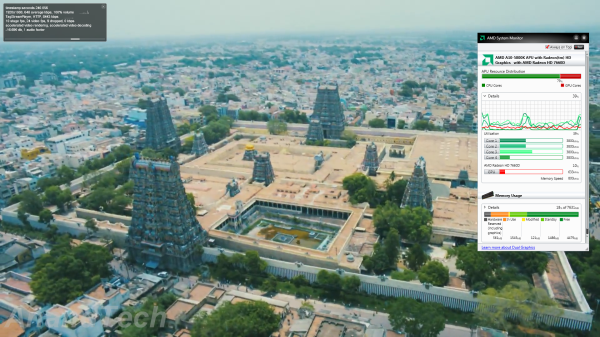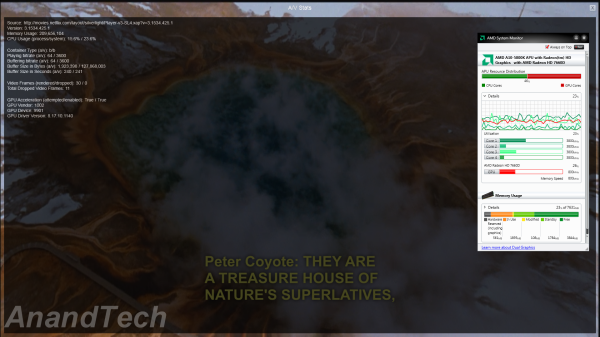AMD's Trinity : An HTPC Perspective
by Ganesh T S on September 27, 2012 11:00 AM ESTFlash acceleration has traditionally worked without issues in AMD and NVIDIA drivers, unlike Intel. Intel and Adobe got it right with Ivy Bridge. Fortunately, things look good with Trinity too. As the screenshot below indicates, we have full GPU acceleration for both decoding and rendering. AMD's System Monitor shows how the CPU and GPU resources are balanced when playing H.264 Flash videos.
Netflix streaming, on the other hand, uses Microsoft's Silverlight technology. Unlike Flash, hardware acceleration for the video decode process is not controlled by the user. It is up to the server side code to attempt GPU acceleration. Thankfully, Netflix does try to take advantage of the GPU's capabilities.
This is evident from the A/V stats recorded while streaming a Netflix HD video at the maximum possible bitrate of 3.7 Mbps. The high GPU usage in the AMD System Monitor also points to hardware acceleration being utilized.
One point which deserves mention here is that Flash and Silverlight acceleration works without hiccups here, unlike what we saw in the Brazos-based machines (where the CPU was too weak despite the availability of hardware acceleration through the GPU).












49 Comments
View All Comments
Beenthere - Thursday, September 27, 2012 - link
There is an appropriate CPU/APU model for every budget these days. Virtually any current model APU/CPU will perform just fine for 98% of consumers. Most consumers buy what fits their needs and budget, not the over priced, over hyped top-of-the-line models.AMDs new Trinity APUs and Vishera desktop FX processors offer more performance for less, which is good for consumers.
silverblue - Thursday, September 27, 2012 - link
We don't know about Vishera, not yet anyway. We don't know what the improvements over Bulldozer will yield as a whole, only what a couple of benchmarks showed in a brief Toms comparison between Trinity and Zambezi. There are plenty of scenarios to consider.Beenthere - Thursday, September 27, 2012 - link
Yes some of us do know the results... Comparing Trintiy to Vishera is incorrect. Vishera is to be compared to Zambezi.AMD has hit their projected 10-15% gains for Vishera compared to Zambezi. Some people already know the results but the NDA doesn't expire for a few weeks so they can't print them yet. Most folks will be happy with Vishera except the haters.
silverblue - Thursday, September 27, 2012 - link
I'd find it hard to believe you were personally under NDA (please prove me wrong). I also believe the gains were per clock, which should theoretically, given the assumption you stated, result in a slightly larger performance gap between the 8150 and the 8350 as the latter has a higher base clock and is more likely to hit max turbo speed.Like I said though, two benchmarks in the public domain aren't gospel, regardless of whether we're comparing Vishera OR Trinity to Zambezi. Remember that L3 cache doesn't always help, but when it does, the gains can be significant, meaning the A10-5800K could occasionally be outperformed by a similarly clocked 41x0 CPU, but the flip side is that it could occasionally perform on par with a similarly clocked 43x0 CPU.
Death666Angel - Thursday, September 27, 2012 - link
"AMD was a little late in getting to the CPU - GPU party. Their first endeavour, the Llano APU"Aren't Zacate and Ontario APUs? They were released in 01/2011, half a year before Llano. Or aren't you counting low power APUs? :)
Thanks for the article!
Death666Angel - Thursday, September 27, 2012 - link
Mea culpa, didn't read the comments before posting my own. :) Disregard.EnzoFX - Thursday, September 27, 2012 - link
What's the big deal with 4k at THIS moment? There are no 4k tv's out are there? By the time they're out, or by the time they're actually affordable by a decent amount of consumers, we would have several generations of new apu's.Denithor - Tuesday, October 2, 2012 - link
http://www.lg.com/us/tvs/lg-84LM9600-led-tvAllio - Thursday, September 27, 2012 - link
These HTPC-perspective articles are consistently some of the most useful and interesting content that AT puts up. As far as I can tell, there really aren't any other tech sites that delve this deep into this kind of functionality - most reviews settle for playing a 1080p Bluray and posting a screenshot of the CPU usage in task manager. While it may only be a relatively small audience for who this stuff is relevant, we are a very interested audience, and I personally appreciate every detail and statistic included. Thanks Ganesh!wharris1 - Thursday, September 27, 2012 - link
At this point, it seems 4k is more marketing hype. I'll link this article: http://reviews.cnet.com/8301-33199_7-57491766-221/...For the typical anandtech readers (probably much more technically gifted than me) I also recall reading a similar article/post on avsforums explaining that for any display size <~100 inches, the 4k standard is hard to justify. Also, while I know that future proofing is sound, there is very little content or ability to play back said content at that resolution. As a previous poster mentioned, by the time 4k becomes a standard, the current platforms will seem antiquated. Anyway, Anandtech is the best tech site around by far; read it every morning.